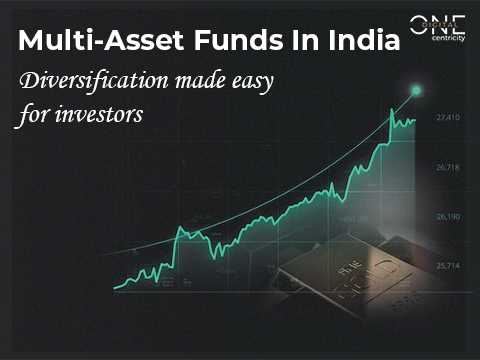Do you need multi-asset funds in your portfolio?
24th November 2023 | Author : Centricity

In the investment world, there is a saying, “Don’t put all your eggs in one basket”. What does this saying mean?
This states that by investing in a variety of assets, your investment aims to reduce the risk associated with having all your money in one type of fund. In the dynamic world of finance, constructing a well-diversified investment portfolio is a key strategy for managing risk and maximizing returns. One approach gaining popularity among investors is the inclusion of multi-asset funds. These funds offer a diversified mix of various asset classes, providing potential benefits that single-asset investments may not deliver. In this article, we will explore why you might want to consider incorporating multi-asset funds into your investment portfolio. This approach is often used to achieve a more stable and consistent return on investment over the long term.
The question is, how do we do it? Multi-asset funds are used for this!
WHAT ARE MULTI-ASSET FUNDS?
A multi-asset fund is a type of investment fund that spreads its money across different types of assets or investments. These assets can include stocks, bonds, real estate, and other financial instruments. The idea behind a multi-asset fund is to create a diversified portfolio, which means not putting all your eggs in one basket. Investors must invest at least 10% of their assets in three asset classes: equity, debt, and gold. These funds often include a mix of equity, debt, and one or more asset classes such as gold, real estate, and so on Investors who choose multi-asset funds are typically looking for a way to benefit from different market opportunities while managing risk. The specific mix of assets in a multi-asset fund can vary, and fund managers may adjust the allocation based on their outlook for the economy and financial markets.
Why choose multi-asset funds?
1. Risk Mitigation
One of the primary advantages of multi-asset funds is their ability to mitigate risk through diversification. By investing in a mix of asset classes such as stocks, bonds, real estate, and commodities, these funds spread risk across different market segments. This diversification helps cushion the impact of poor-performing assets, potentially reducing overall portfolio volatility. In times of economic uncertainty or market downturns, this risk mitigation can be particularly valuable.
2. Market Exposure and Growth Potential:
Multi-asset funds provide exposure to a broader range of investment opportunities than single-asset funds. This allows investors to participate in various market trends and capitalize on growth opportunities across different sectors. As some assets may perform well while others underperform, having a mix of investments can enhance the portfolio's overall growth potential.
3. Adaptive to Market Conditions:
The financial markets are dynamic, and different asset classes may perform better under varying economic conditions. Multi-asset funds are managed by professionals who actively allocate assets based on market trends and economic indicators. This adaptability allows these funds to capitalize on opportunities and adjust to changing market conditions, potentially providing better risk-adjusted returns.
4. Simplified Portfolio Management:
For investors who prefer a hands-off approach to portfolio management, multi-asset funds offer a convenient solution. Rather than selecting and managing individual securities, investors can rely on fund managers to make strategic asset allocation decisions. This can save time and effort while still allowing investors to benefit from a diversified portfolio.
Performance of Multi-Asset Funds:
Below you'll find graphs stating the RETURNS of multi-asset funds over the last 3 and 5 years.
3-Year Rolling Returns:

Source: Motilal Oswal Mutual Fund
5-Year Rolling Returns:

Source: Motilal Oswal Mutual Fund
In the realm of investment, the hottest thing right now might not be the best one tomorrow.
Mentioned below is a table that represents how different asset classes have alternated in leading the return category since 2005. There were times when domestic equities did better, while due to robust economic growth, there were times when gold performed better during times of inflation or economic uncertainty.

Source: Motilal Oswal Mutual Fund
Regardless of the circumstances, investors are better positioned to seize opportunities if their portfolio consists of a combination of these asset groups.
In conclusion, incorporating multi-asset funds into your investment portfolio can offer several advantages. From risk mitigation through diversification to exposure to various market trends and adaptive management, these funds provide a holistic approach to investing. While no investment strategy is without risk, the potential benefits of multi-asset funds make them a compelling option for investors looking to achieve a balanced and diversified portfolio.
Before making any investment decisions, it's essential to carefully assess your financial goals, risk tolerance, and investment time horizon to ensure your investment strategy aligns with your overall financial future!
Disclaimer: The above information should not be relied upon for personal or financial decisions, and you should consult an appropriate financial professional for specific advice. The information presented under our newsletter and blogs is solely for informational purpose

Thematic Funds in India: A Growing Trend in Investment!
30th January 2025

Are you investing in SIPs smartly ?
21st January 2025

Multi-Asset Funds in India: Diversification Made Easy for Investors
16th December 2024

Multi-Cap vs Flexi-Cap Mutual Funds: Where to Invest in 2024?
26th September 2024


